Imagine a flash of electric blue, fiery orange, and emerald green cutting through the sunlight—a rainbow lorikeet in flight. These birds aren’t just colorful parrots; they’re living bursts of nature’s brilliance. For anyone who’s ever paused to watch their acrobatic moves or admired their kaleidoscope feathers, this guide offers essential information to deepen your connection with these iconic creatures.
Whether you’re a birder marveling at their wild habitats or considering them as pets, this guide explores their vibrant world. Discover their wild origins, dietary needs, and the responsibilities of ownership. Every detail here balances admiration for their beauty with practical insights, ensuring you understand both their wild spirit and care requirements. Let’s dive into the rainbow lorikeet’s story—one feather, one fact, at a time.
Rainbow Lorikeet
Exploring the rainbow lorikeet’s origins, physical traits, and scientific classification is fascinating. This colorful parrot is a natural wonder, showing us the beauty of bird diversity.
Origin and Natural Distribution
These birds come from Australia, Indonesia, and Papua New Guinea. They love tropical and subtropical forests. Humans have also introduced them to New Zealand.
They can live in cities, parks, and woodlands too. Their ability to adapt is impressive.
Physical Characteristics and Identification
Adult rainbow lorikeets are 25–30 cm long and weigh 120–130g. Their feathers are a mix of blues, greens, oranges, and reds. This makes them stand out.
They have a special tongue for eating nectar and fruits. Males are brighter than females, helping us tell them apart.
- Key traits: Brightly patterned feathers, orange beaks, and striking wing markings.
- Behavioral clue: Noisy calls and aerial acrobatics help locate them in the wild.
Taxonomy and Related Species
The rainbow lorikeet is scientifically named Trichoglossus moluccanus. It used to be called Trichoglossus haematodus. It’s part of the Trichoglossus genus, with 22 species of lorikeets.
Its relatives, like the scaly-breasted lorikeet, have gray scalloped feathers and quieter calls. Learning about their taxonomy helps us understand their evolution and how they fit into their ecosystems.
The Vibrant Appearance of Rainbow Lorikeets
Rainbow lorikeets are known for their bright colors. Their heads and bellies glow in electric blue, while their wings and tails are emerald green. A bright orange-red breast completes their stunning look.
These colors play a big role in nature. Both males and females have the same colors, but young birds start with duller green feathers. They take 12–18 months to grow into their vibrant colors.
Scientists say these colors help in finding a mate and recognizing their species. They also make it easier for them to be seen in the dense rainforest canopy. Here’s a breakdown of their key features:
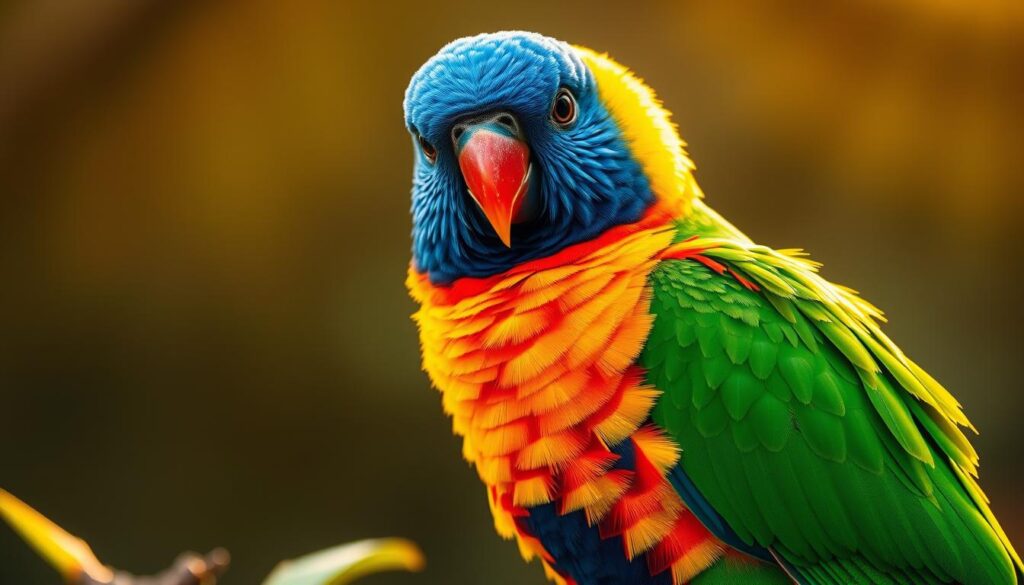
- Head: Turquoise-blue crown and cheeks
- Chest: Orange-red patch extending to the throat
- Wings: Lustrous green with black wingtips
There are three main subspecies, each with slight differences:
| Subspecies | Location | Key Color Traits |
|---|---|---|
| Greenway’s lorikeet | Northern Australia | Paler red chests |
| Forsten’s lorikeet | New Guinea | Stronger blue contrasts |
| Cape York lorikeet | Northern Queensland | Deeper violet undertones |
This shows why rainbow lorikeets are among the most photographed colorful parrots. Their colors are not just beautiful but also help them survive. This makes them famous in wildlife shows and pet markets.
Natural Habitat and Distribution

Learning about the rainbow lorikeet’s home is vital for their survival. They need places with food, shelter, and where they can nest. This part talks about where they live and what they need to thrive.
Native Range in Australia and Surrounding Islands
These birds mainly live along Australia’s east coast, from Queensland to South Australia. They also live in Tasmania and places like New Guinea. In Western Australia, they’ve made homes in Perth’s cities.
Preferred Environmental Conditions
They love places full of nectar. Their favorite spots include:
- Moist coastal forests
- Subtropical rainforests
- Woodlands with eucalyptus trees
- Urban parks and gardens
Impact of Habitat Loss
| Threat | Effect | Conservation Response |
|---|---|---|
| Deforestation | Reduces nesting sites | Protected forest reserves |
| Urban expansion | Fragmented food sources | City tree-planting programs |
| Climate shifts | Delayed flowering cycles | Long-term ecological monitoring |
Knowing about these problems helps us protect them. We must find a balance between building and keeping nature safe. This way, they can survive in our changing world.
Rainbow Lorikeet Behavior in the Wild
Learning about the rainbow lorikeet’s natural behavior is key for those who care for them. These birds love to be around others and communicate well. This is important to know when caring for them in captivity.
Social Structure and Flocking Behavior
Rainbow lorikeets live in groups of up to 50 birds. These groups work together to find food, build nests, and stay safe from predators. They often stay with their mates for life, sharing tasks like feeding and raising young.
- Lifelong monogamous breeding pairs
- Cooperative flock foraging strategies
- Group roosting at night for safety
Communication Methods and Vocalizations
Wild rainbow lorikeets use many sounds to keep their flock together. They communicate in different ways, including:
| Call Type | Description | Purpose |
|---|---|---|
| Alarm Calls | Sharp, rapid screeches | Signal danger |
| Contact Calls | Soft, musical warbles | Maintain flock unity |
They also use non-vocal signals like:
- Head bobbing during mating displays
- Wing-fluttering to signal submission
- Rapid tail movements during territorial disputes
Daily Activity Patterns
The daily life of a wild rainbow lorikeet follows a pattern:
- Dawn: Flocks gather at sunrise to eat nectar and fruits
- Noon: They rest in shaded trees during the hottest part of the day
- Dusk: They preen and make sounds before settling in for the night
During breeding season, which is from August to January in Australia, they are more active and territorial.
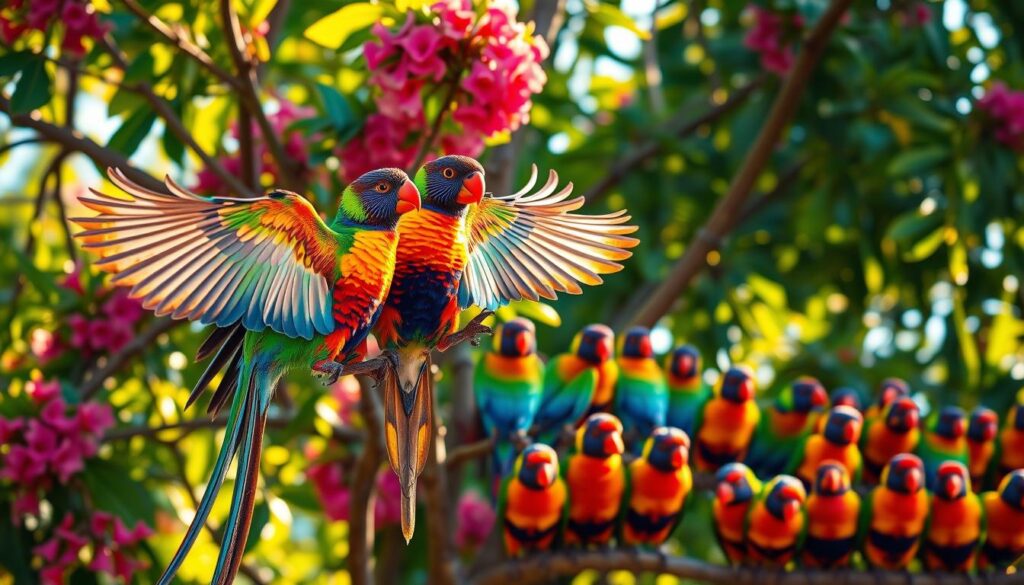
Nutritional Requirements and Diet
Rainbow lorikeets need a diet full of natural sugars and nutrients. Their tongues are made to get nectar from flowers. This is a big part of their diet. Wild rainbow lorikeet populations eat native plants like eucalyptus and bottlebrush. These plants give them nectar, pollen, and sometimes insects.
In captivity, it’s important to match their diet. A good diet has commercial nectar mixes, fresh fruits like apples and papaya, and some protein like boiled eggs. Don’t just give them seeds, as they can cause health problems like liver disease.
- Nectar: 50% of daily intake, using brands like Lafeber’s or Nekton.
- Fruits: Give mango, blueberries, and pears—skip avocado and citrus.
- Supplements: Mix calcium and vitamin A powders into their food.
| Food Type | Wild Source | Captive Option |
|---|---|---|
| Nectar | Flowers | Commercial mixes |
| Fruits | Wild berries | Apples, bananas |
| Protein | Insects | Boiled egg, mealworms |
A care guide should stress the importance of fresh and varied food. Use shallow dishes and clean them every day. Young lorikeets need more protein, and adults should eat 2-3 times a day. Always talk to an avian vet for specific advice. The right food keeps their feathers bright and their energy up, which is key for their lively lives.
Umbrella Cockatoos: Captivating Companions for Your Home
Rainbow Lorikeet as a Pet
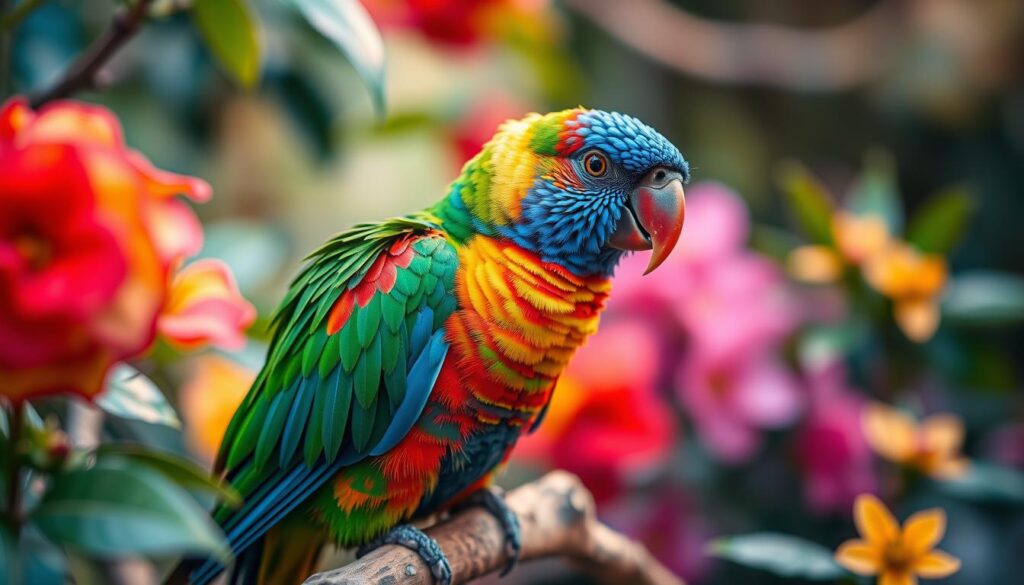
Thinking about getting a rainbow lorikeet as a pet needs careful thought. These colorful birds need special care to do well at home. Make sure you know the rules and can meet their needs before getting one, as explained in this care guide.
Legal Considerations in the United States
Rules about owning these birds vary by state. In places like California, Hawaii, and Florida, you need a permit because they might harm local ecosystems. If you live in these states, you must apply for permission. In other areas, owning them might be banned. Always check with local wildlife agencies first.
Space Requirements and Housing
These birds are very active and need lots of room. The size of their cage is very important for their health.
| Category | Requirement |
|---|---|
| Cage size | Minimum 36”W x 24”D x 36”H |
| Bar spacing | ½” to 5/8” apart |
| Material | Stainless steel or powder-coated metal |
Outdoor aviaries are best in mild weather. They keep the birds safe from predators and harsh weather.
Socialization and Training Tips
- Start daily hand-taming sessions with treats
- Use clicker training for commands like “step up”
- Provide quiet spots to avoid overstimulation
Common Health Concerns
Feeding them the right food is key to avoid health problems. Watch out for:
- Respiratory infections from damp places
- Psittacosis symptoms like hard breathing
- Feather plucking due to stress
Take them to avian specialists for check-ups every year to keep them healthy.
Rainbow Lorikeet Price Factors
Getting a rainbow lorikeet as a pet is more than just the initial cost. You need to think about ongoing expenses and making ethical choices for the long run.
Average Cost in the US Market
Rainbow lorikeet prices change based on things like age and color. Birds hand-raised by experts can cost $800–$2,500. Birds with special colors or patterns cost even more. Birds raised by their parents might be cheaper but need more time to get used to people.
Additional Expenses to Consider
Being a pet owner means more than just buying a bird. You’ll need to budget for:
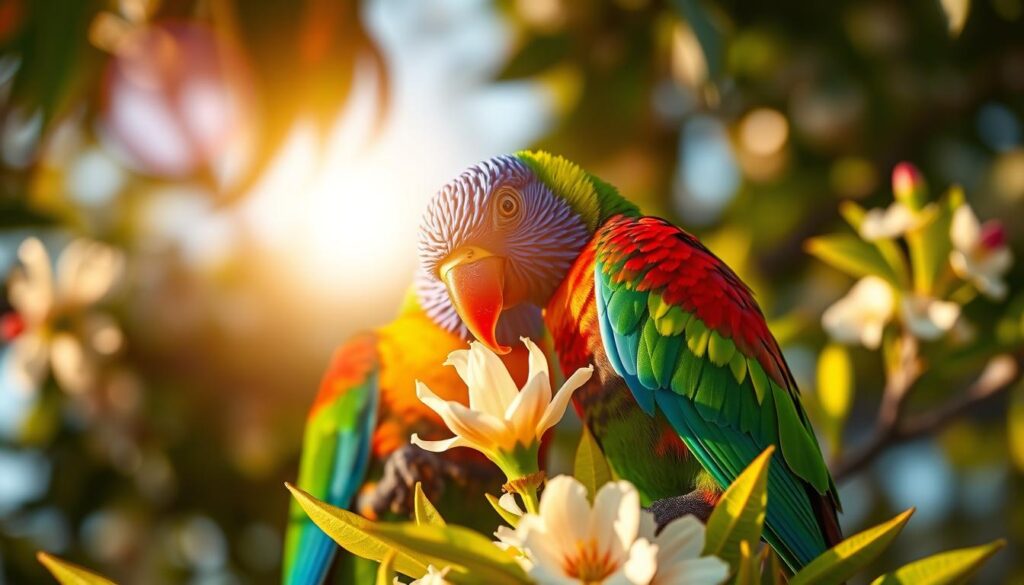
- Cage and accessories: $300–$600
- Special nectar food: $20–$30/month
- First vet visit: $100–$200
Every year, you’ll spend $1,200+ on vet visits, toys, and fresh food. Emergency vet visits can add extra costs.
Ethical Sourcing Considerations
| Reputable Breeders | Unethical Sources |
|---|---|
| Give health certificates and pedigree info | No papers or health promises |
| Start socializing birds early | Keep birds in crowded places |
| Be open about breeding methods | Low prices for poor quality birds |
Always check with breeders about health checks and socialization. Adopting from rescue groups can be cheaper and support good practices.
Breeding Rainbow Lorikeets in Captivity
Breeding rainbow lorikeets needs careful planning and following a care guide. It’s important to have the right nesting boxes, healthy birds, and the right environment. This includes changing their diet with the seasons.
- Nesting boxes: Use 12x12x18″ wooden boxes mounted 6-8ft high. Provide soft nesting material inside.
- Breeding age: Wait until birds are 1-2 years old and in prime health.
- Stimulate breeding with increased fruit intake and longer daylight hours.
| Stage | Duration | Key Details |
|---|---|---|
| Courtship | 1-2 weeks | Feather displays and vocal exchanges |
| Egg laying | 2-3 days | Typically 2 eggs per clutch |
| Incubation | 25 days | Both parents share incubation duties |
| Weaning | 6-8 weeks | Chicks fledge at 6 weeks but stay dependent |
- Egg binding: Provide calcium-rich diets and monitor egg size
- Parent neglect: Use brooder boxes if necessary
- Infertility: Ensure genetic diversity through pairing
Ethical breeding focuses on genetic health, not just numbers. It’s important to avoid inbreeding by using unrelated pairs. Hand-raised chicks need special formula every 2-3 hours. Breeders must also socialize chicks for life in a home.
Environmental Enrichment for Captive Lorikeets
Keeping a rainbow lorikeet happy is more than just food and a place to sleep. A good care guide must include mental stimulation. This helps them act like they’re in the wild. Activities that keep them busy, reduce stress, and bring out their natural behaviors are key.
Toys and Recreational Activities
Interactive toys help them forage, which is good for their health. You can offer:
- Puzzle feeders with hidden treats
- Destructible toys made from wood or cardboard
- Swinging perches for movement
Change toys every week to keep them interested. Make sure they’re big enough so they can’t swallow them.
Creating a Stimulating Habitat
A good home for your lorikeet is essential. It should have:
- Varying perch diameters and materials (wood, rope, PVC)
- Plants or hanging vines for climbing
- Food stations placed at different cage heights
- Weather-appropriate outdoor aviaries if possible
Social Interaction
Rainbow lorikeets need friends. Spend time with them every day, doing:
- 15–30 minutes of supervised out-of-cage time
- Training sessions with positive reinforcement
- Regular verbal interaction and mimicry games
Having more than one lorikeet can help with loneliness. But, you’ll need more space. Make sure they get along well.
Conservation Status and Efforts
Rainbow lorikeets are colorful but face big conservation challenges. They are listed as Least Concern by the IUCN Red List. But, their ability to adapt and wide habitat range hide local threats. Human actions harm their homes, putting their future at risk.
- Habitat fragmentation from urban expansion
- Competition with invasive species like European honeybees
- Climate shifts altering native plant blooming cycles
- Road collisions in populated areas
Efforts to save them include:
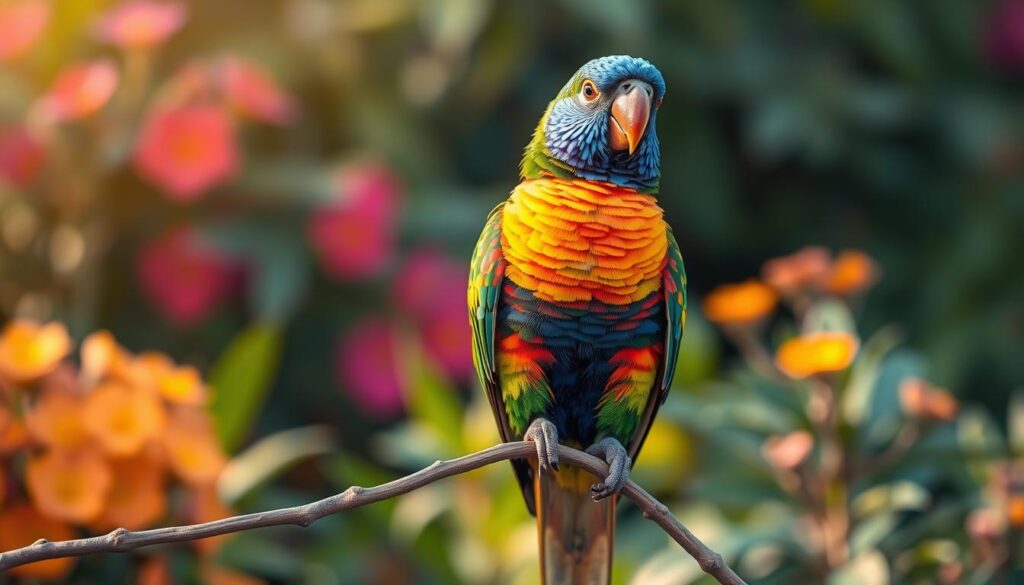
| Action | Goal |
|---|---|
| Habitat corridors | Connect fragmented forests |
| Community education | Reduce intentional feeding |
| Wildlife crossings | Reduce vehicle-related deaths |
| Seed dispersal programs | Support native plant recovery |
In Australia, they are protected, but in New Zealand, they are seen as pests. Saving them means managing their numbers and stopping them from spreading. Educational efforts teach people to plant native plants instead of feeding them sweets. Scientists track their numbers to help make better plans for their survival.
Conclusion: Is a Rainbow Lorikeet Right for You?
Thinking about getting a rainbow lorikeet as a pet? They need special food, lots of interaction, and plenty of room. They live for 10–15 years, so you’re making a big commitment.
These birds are colorful and fun, but they can be loud and messy. If you live in an apartment, think carefully if they’re right for you.
Before you decide, check if you have enough space and can afford their diet and vet bills. Also, make sure you have time for their daily needs. It’s important to buy from ethical breeders to avoid supporting bad practices.
If you can’t take on the responsibility of owning a lorikeet, there are other ways to enjoy them. You could donate to conservation groups or visit places with lorikeet programs. These options let you appreciate these birds without the long-term commitment of pet ownership.
FAQ
What is the average lifespan of a rainbow lorikeet?
Rainbow lorikeets can live up to 15 years if they are well cared for as pets.
What should a rainbow lorikeet’s diet consist of?
Their diet should include nectar, pollen, fruits, and lorikeet food. Avoid a diet that only includes seeds.
How should I set up a habitat for my rainbow lorikeet?
Give them a big cage with the right bar spacing. Add multiple perches and toys. Make sure it’s like their natural home with places to climb and play.
Are rainbow lorikeets good pets for families?
Yes, they can be great pets for families. But, they are very active and can be loud. This might not be good for small kids or people living in apartments.
How can I socialize my rainbow lorikeet?
Start handling them when they are young. Use positive reinforcement and spend time with them. This helps build trust and a bond.
What are the common health concerns for rainbow lorikeets?
They can get nutritional deficiencies, respiratory infections, and stress-related health issues. It’s important to take them to an avian specialist for regular check-ups.
Can rainbow lorikeets be kept with other birds?
It’s best to be careful when keeping them with other birds. Their social behavior can sometimes cause territorial disputes or stress.
What factors affect the price of a rainbow lorikeet?
The price depends on the bird’s age, color, the breeder’s reputation, and if they were hand-raised or not.
Are there legal restrictions on owning rainbow lorikeets?
Yes, laws about owning them vary by state in the U.S. Always check local laws and if you need any permits.
How can I enrich the environment for my captive rainbow lorikeet?
Give them different toys, let them out of their cage often, and offer foraging and social activities. This keeps them happy and mentally sharp.


